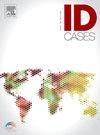Cutaneous anthrax rapidly progressed into septic anthrax resulting in death – A case report
IF 1
Q4 INFECTIOUS DISEASES
引用次数: 0
Abstract
Anthrax is a fatal zoonotic disease and the acute risk associated with it cannot be underestimated. Cutaneous anthrax accounts for more than 95 % of anthrax and usually does not lead to death. We present a case of severe cutaneous anthrax treated with a three-day course of combination antibiotics therapy, which culminated into death due to multiple organ failure. The patient did not exhibit symptoms suspected of meningitis anthrax and pulmonary anthrax. Computed Tomography revealed subcutaneous exudates in the chest, back, left supraclavicular fossa, and bilateral axillary regions. Some newly factors, like hypotension, elevated creatinine, acidosis, and a urinary tract infection, provide valuable insights into the clinical intervention in early. In rural areas, educating residents about anthrax symptoms and risks is crucial.
皮肤炭疽迅速发展为脓毒性炭疽导致死亡1例报告
炭疽是一种致命的人畜共患疾病,与之相关的急性风险不容低估。皮肤炭疽占炭疽的95% %以上,通常不会导致死亡。我们提出一个病例严重皮肤炭疽与三天疗程的联合抗生素治疗,最终死亡,由于多器官衰竭。病人没有出现疑似脑膜炎、炭疽和肺炭疽的症状。计算机断层扫描显示胸部、背部、左侧锁骨上窝和双侧腋窝有皮下渗出物。一些新的因素,如低血压、肌酐升高、酸中毒和尿路感染,为早期临床干预提供了有价值的见解。在农村地区,教育居民了解炭疽的症状和风险至关重要。
本文章由计算机程序翻译,如有差异,请以英文原文为准。
求助全文
约1分钟内获得全文
求助全文

 求助内容:
求助内容: 应助结果提醒方式:
应助结果提醒方式:


